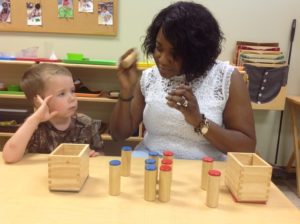
Today, we’d like to share the experience of Celia Arseneault, who completed our MCTD program and now teaches at The Montessori Children’s Academy in Short Hills. Her unique experience offers insight into different teaching options to consider after completing a Montessori Teacher Education Program.
When I embarked upon my career to become a Montessori teacher, I did so because of my children. I saw firsthand how each child learns differently and how the freedom of movement in a prepared environment empowers them to choose work of their own accord or to their own ability. In the words of Maria Montessori, children desire for us to “Help me do it by myself”. Little did I know that this journey would be one of self-discovery. This venture was made possible by MCTD and its caring and devoted staff. The support they provided kept me enthused and determined to succeed even in the face of challenges.
As an intern in the program and later as part-time Assistant Teacher, I learned how to create a prepared Montessori environment, the proper handling of Montessori manipulatives, and the importance of observation. With all this preparation and my Montessori certification in hand, one would think that stepping up to the position of a Head Teacher would be a simple matter. However, life has thought me that successful people often make success look effortless and that such a position was not to be entered into lightly because it affects the formative years and sensitive periods of a child. Therefore, when an opportunity to co-lead an afternoon class was presented by The Montessori Children Academy of Short Hills, I saw it as the perfect way to bridge a gap.
The gap I’m referring to is the learning curve or transition from Assistant to Head Teacher. As a co-lead, you share the responsibility and accountability of a classroom with another directress. Responsibilities such as Parent-Teacher Meetings, monthly newsletters, classroom management, and seasonal projects (such as Mother’s Day gifts) are made more manageable and can be more successful when undertaken with a partner. Co-lead is a shared time commitment and allows for exchange of ideas and collaboration; additionally, your co-teacher can provide back-up in the case of family emergency or short-term personal illness. The knowledge that you’re not in it alone is ever present and reassuring.
A co-lead experience certainly comes with its own challenges, as well, and these must be recognized. This type of teaching experience requires the two individuals involved to be respectful of each other’s style of teaching. So long as the teachers both show respect for the children, the classroom, and one another, they must acknowledge that differences in their teaching approaches may provide some balance for their students. Another challenge co-teachers may face is when other co-workers within the school, perhaps for ease of time, may be less inclined to discuss all matters with both teachers, which can lead to a breakdown in communication and cause confusion. In this instance, the teachers must make a concerted effort to share any important information with their co-teachers soon after they receive it. Still another consideration when co-teaching is if teachers have different ideas on how to present a lesson. This type of situations must be resolved if they are to present a united front, and it is usually best if teachers ‘tour’ their classroom together to discuss how they present lessons with the materials. Most importantly in a co-lead situation, the work load must not fall too heavily on one individual as resentment will surely brew and concerns of economic inequality can become a factor. While there are challenges, the best method to address them is to begin the co-teaching experience with open communication and to continue keeping that communication flowing honestly and respectfully throughout the year.
Co-lead teachers may find themselves in a situation where one of the directresses may be senior to the other. This type of relationship can prove to be a wonderful a mentorship where there is the passing down of a wealth of experience and information regarding children’s development. The co-lead experience might also be a mutual exchange of currently trending ideas with teachers who are of the same experience level. Either way, both teachers are the wiser as a result of working with a partner. It has been my experience that a joint venture such as this can be the most helpful in terms of developing experience for a new teacher, and it certainly prepares one for the things that lay ahead. A successfully engaged co-lead year essentially bridges all the gaps and can be advantageous if nurtured and handled with respect, grace, and courtesy…the Montessori way.

